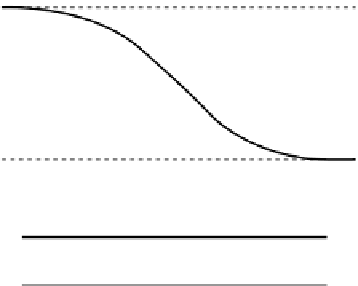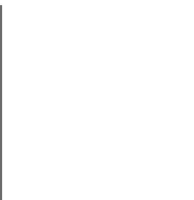Geology Reference
In-Depth Information
(a)
(b)
ρ
a
ρ
a
ρ
a
ρ
1
ρ
2
>
ρ
3
>
ρ
1
ρ
1
>
ρ
2
>
ρ
3
ρ
2
ρ
3
>
ρ
1
>
ρ
2
ρ
3
>
ρ
2
>
ρ
1
a
a
a
ρ
1
ρ
1
ρ
2
ρ
2
<
ρ
1
ρ
3
Fig. 8.8
The variation of apparent resistivity
r
a
with electrode
separation
a
over a single horizontal interface between media with
resistivities
r
1
and
r
2
.
Fig. 8.9
The variation of apparent resistivity
r
a
, with electrode
separation
a
over three horizontal layers.
solution of Laplace's equation (Section 6.11) and inser-
tion of the boundary conditions for the particular struc-
ture under consideration, or by integrating it directly. In
practice such solutions are invariably complex. Conse-
quently, a simplified approach is initially adopted here
in which electric fields are assumed to act in a manner
similar to light. It should be remembered, however, that
such an optical analogue is not strictly valid in all cases.
large electrode spacings, the presence of the intermedi-
ate layer causes a deflection of the apparent resistivity
curve at intermediate spacings. If the resistivity of the in-
termediate layer is greater or less than the resistivities of
the upper and lower layers the apparent resistivity curve
is either bell-shaped or basin-shaped (Fig. 8.9(a)). A
middle layer with a resistivity intermediate between
r
1
and
r
3
produces apparent resistivity curves characterized
by a progressive increase or decrease in resistivity as a
function of electrode spacing (Fig. 8.9(b)).The presence
of four or more layers further increases the complexity of
apparent resistivity curves.
Simple examination of the way in which apparent re-
sistivity varies with electrode spacing may thus provide
estimates of the resistivities of the upper and lower layers
and indicate the relative resistivities of any intermediate
layers. In order to compute layer thicknesses it is neces-
sary to be able to calculate the apparent resistivity of a lay-
ered structure. The first computation of this type was
performed by Hummel in the 1930s using an optical
analogue to calculate the apparent resistivity signature of
a simple two-layered model.
Referring to Fig. 8.10, current
I
is introduced into
the ground at point C
0
above a single interface at depth
z
between an upper medium 1 of resistivity
r
1
and a lower
medium 2 of resistivity
r
2
. The two parallel interfaces
between media 1 and 2 and between medium 1 and the
air produce an infinite series of images of the source,
located above and below the surface. Thus C
1
is the
image of C
0
in the medium 1/2 interface at depth 2
z
,
8.2.7 Vertical electrical sounding interpretation
Consider a Wenner electrode spread above a single hori-
zontal interface between media with resistivities
r
1
(upper) and
r
2
(lower) with
r
1
>
r
2
(Fig. 8.8). On passing
through the interface the current flow lines are
deflected towards the interface in a fashion similar to
refracted seismic waves (Chapter 3) since the less
resistive lower layer provides a more attractive path for
the current.When the electrode separation is small, most
of the current flows in the upper layer with the conse-
quence that the apparent resistivity tends towards
r
1
.As
the electrode separation is gradually increased, more and
more current flows within the lower layer and the appar-
ent resistivity then approaches
r
2
. A similar situation ob-
tains when
r
2
>
r
1
, although in this case the apparent
resistivity approaches
r
2
more gradually as the more re-
sistive lower layer is a less attractive path for the current.
Where three horizontal layers are present the apparent
resistivity curves are more complex (Fig. 8.9). Although
the apparent resistivity approaches
r
1
and
r
3
for small and























